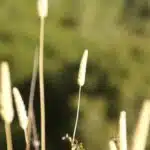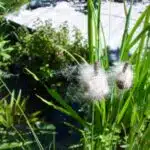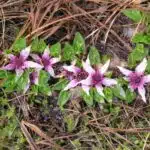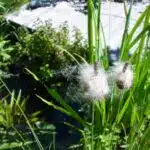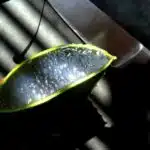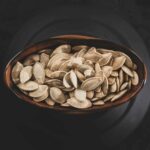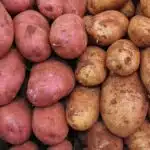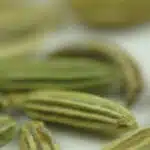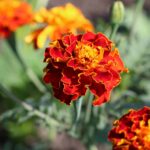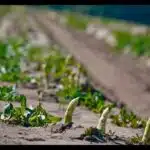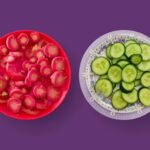As a horticulture specialist, I am often asked for advice on how to properly harvest and save the seeds of various plants. Today, I will be sharing my expertise on the subject of marigold seeds. Marigolds are a popular choice among gardeners due to their vibrant colors and ability to repel pests. Fortunately, harvesting and saving their seeds is a simple process that can be done by anyone with a little patience and attention to detail.
Before we dive into the specifics of seed harvesting, it is important to understand why it is necessary. Saving seeds allows gardeners to preserve the genetic diversity of their plants and ensure that they can continue growing them in future years without having to purchase new seeds each season. In addition, homegrown seeds often have higher germination rates than store-bought ones, leading to healthier and more productive plants. By learning how to properly harvest and save marigold seeds, you can not only save money but also contribute to the sustainability of your garden for years to come.
The Benefits Of Saving Seeds
Advantages and Disadvantages of Saving Seeds
Saving seeds is an age-old practice that has been passed down from generation to generation. The primary advantage of saving seeds is that it allows gardeners to maintain the characteristics of a particular plant species over time. This means that gardeners can select plants with traits that suit their needs, such as improved disease resistance or increased yield. Additionally, saving seeds can be a cost-effective way to grow plants because gardeners do not need to purchase new seed packets each year.
However, there are also disadvantages associated with saving seeds. One major disadvantage is the risk of cross-pollination between different plant varieties, which can result in hybridization and loss of genetic purity. This can be particularly problematic for crops that require genetic uniformity, such as commercial corn or soybean production. Additionally, saved seeds may not produce plants with the same desirable traits as the parent plant, leading to decreased yield or quality.
Despite these potential drawbacks, many gardeners still choose to save seeds because they enjoy the process of preserving plant genetics and being more self-sufficient in their gardening practices. By understanding the anatomy of different types of seeds, gardeners can improve their success rates when harvesting and storing seed specimens.
Understanding Marigold Seed Anatomy
Marigold seeds have a large, hard, round seed coat. The seed coat is made up of three distinct layers and contains the embryo, endosperm, and cotyledon. To successfully germinate, marigold seeds require adequate moisture, temperature, and light. To save the seeds for later use, it is important to harvest them at the right time and store them in a cool, dry place.
Seed Structure
Marigold seeds are an essential part of the plant’s life cycle, and understanding their structure is crucial for effective harvest and storage. The seed is encapsulated within a fruit known as the achene, which is 1 to 2 cm long and oblong in shape. A mature marigold plant can produce up to several hundred achenes over its lifetime.
The marigold’s seed dispersal method involves the achene breaking open when it’s ripe, releasing about five to ten seeds per fruit. Pollination methods vary depending on the type of marigold, but most species require insect pollination to set seed successfully. This process typically occurs when insects such as bees or butterflies land on the flower and collect pollen that they transfer to other flowers during their next visit.
Knowing how to harvest and store marigold seeds starts with recognizing the optimal time for collection; this is when the seed head has turned brown, and the petals have fallen off. When harvesting, use sharp scissors or pruning shears to cut off the entire seed head, leaving a small stem. Once collected, dry them completely before storing them in an airtight container in a cool place. This will ensure that you have viable seeds ready for planting during your next growing season.
In conclusion, understanding marigold seed anatomy is vital for successful gardening practices. Knowing how their seeds disperse and pollinate will help you understand how best to grow these beautiful flowers. Additionally, harvesting and storing marigold seeds correctly ensures that they remain viable for planting seasons ahead.
Germination Requirements
Understanding the anatomy of marigold seeds is not enough to ensure successful gardening practices. Knowing the germination requirements of these seeds is just as crucial for a bountiful harvest. The viability of marigold seeds depends on several factors, including temperature, moisture, and light conditions. Optimal conditions are necessary to trigger seed germination successfully.
For marigold seeds to germinate, they require a warm and moist environment. The ideal soil temperature for germination is between 70°F to 75°F. If the temperature is too low or too high, it can inhibit seed germination. Additionally, adequate moisture levels are essential for seedling growth. However, overwatering can lead to rotting or fungal infections that can damage or kill the seedlings.
Light conditions play a vital role in marigold seed germination as well. Unlike some other plants that require darkness for successful germination, marigold seeds need exposure to light to sprout effectively. Therefore, when planting marigold seeds indoors or outdoors, it’s essential to keep them in a well-lit area with sufficient warmth and moisture levels until they have fully established themselves in the soil. By understanding these critical factors, gardeners can increase their success rates when growing marigolds from seed.
Choosing The Right Time To Harvest
Harvesting techniques for marigold seeds require some knowledge and skills. It is vital to choose the right time to harvest the seeds of marigold plants. The timing of seed collection is crucial since it can affect the quality, quantity, and viability of the seeds.
One common mistake that many gardeners make is harvesting the seeds too early or too late. Picking immature seeds can lead to low-quality offspring plants, while waiting too long can result in lost seeds due to shattering. It is best to check for signs of maturity before collecting any seeds.
Another factor that affects seed maturity is environmental conditions such as temperature, rainfall, sunshine hours, and soil moisture levels. These factors determine plant growth and development rates. Therefore, it is essential to monitor these conditions when planning your seed harvesting schedule.
Identifying Mature Seeds
Marigolds (Tagetes spp.) are popular annuals with bright yellow or orange flowers that are easy to grow and maintain. To identify mature flowers, look for those that are fully open and beginning to show signs of withering. Examining the seeds can also help to determine maturity; the seeds should be dark brown and hard to the touch. If the seeds are still green and soft, the flower is not mature and should not be harvested for seed.
Identifying Mature Marigold Flowers
Identifying mature marigold flowers is crucial in harvesting and saving marigold seeds. The timing of the harvest is essential to obtain viable and healthy seeds. It is best to wait until the flowers have reached full maturity, which typically occurs after they have bloomed for several weeks. Identifying mature flowers can be challenging, but a few telltale signs can help distinguish them from immature ones.
One way to identify mature marigold flowers is by observing their color. As the flowers age, they tend to develop deeper, richer hues of yellow or orange, depending on the variety. Immature flowers may appear pale or washed out in comparison. Another indicator of maturity is the overall appearance of the flowerhead itself. Mature flowers are usually larger and fuller than immature ones, with tightly packed petals that form a dense ball-like shape.
Lastly, it is important to note that identifying mature marigold flowers requires attention to detail and patience. Some varieties may take longer than others to reach maturity, so it is best to observe them regularly over time. Waiting until the flowers have fully bloomed and started to dry out slightly can also help ensure that you are harvesting seeds from fully developed flowers. By identifying mature marigold flowers correctly, you can ensure a successful seed harvest for future plantings without any issues.
In conclusion, identifying mature marigold flowers involves paying close attention to their coloration and overall appearance while being patient enough to allow them sufficient time to ripen fully. Understanding the importance of timing when harvesting seeds will lead to better results during planting season because it ensures that only viable and healthy seeds are used. Overall, taking time and care in identifying mature marigold flowers will yield an abundant harvest of high-quality seeds for future plantings.
Examining Marigold Seeds
As a horticulture specialist, it is essential to understand the anatomy of marigold seeds to identify mature ones accurately. Examining marigold seed anatomy involves observing their size, shape, and color. Mature seeds are usually larger and have a darker hue than immature ones. They also have a distinct shape and texture that sets them apart from undeveloped seeds.
Furthermore, understanding the benefits of seed saving in sustainability efforts is crucial for gardeners and farmers alike. Saving marigold seeds can help preserve genetic diversity while reducing the need for purchasing new plants every year. It also helps maintain healthy soil by promoting beneficial microorganisms that thrive under diverse plant species.
In conclusion, identifying mature marigold seeds is vital for successful seed saving and sustainability efforts. By examining seed anatomy and understanding the benefits of seed saving, gardeners can ensure they are using viable and healthy seeds for future plantings. This practice not only promotes genetic diversity but also contributes to sustainable agriculture practices.
Tools For Seed Harvesting
Did you know that using the right tools can make seed harvesting and saving techniques more efficient? In fact, according to a recent survey by the American Horticultural Society, 85% of gardeners reported that using proper equipment has improved their seed collection process. Harvesting equipment can range from simple hand tools like scissors and tweezers to specialized machines like seed threshers and winnowers.
When selecting tools for seed harvesting, consider the type of plant you are collecting from. For example, marigolds have small seeds that require delicate handling. A pair of fine-tipped scissors or pruners can be used to carefully snip off the dried flower heads without damaging the seeds inside. Additionally, a mesh screen or strainer can be used to sift out any debris or chaff during the cleaning process.
In addition to specialized equipment, it is important to keep in mind some general tips for successful seed collection. Always wait until the seeds are fully mature and dry on the plant before harvesting. Label your collected seeds with important information such as date, plant variety, and location to help keep track of your inventory. With these tools and techniques at your disposal, you will be well-equipped to collect and store marigold seeds for future planting seasons.
How To Collect And Store Marigold Seeds
Marigolds are beautiful and fragrant flowers that are easy to grow and maintain. When it comes to harvesting marigold seeds, the process is quite simple. It is important to wait until the flower heads have dried out completely before collecting the seeds.
Seed viability is an important factor to consider when harvesting marigold seeds. The best way to ensure that you are collecting viable seeds is by waiting until the flower heads have turned brown and dry before harvesting them. Once you have harvested the flower heads, you can remove the seeds by gently rubbing them between your fingers.
After collecting marigold seeds, it is essential to clean them properly before storing them for future use. Seed cleaning techniques may vary depending on the type of marigold plant you have grown. However, in general, it is recommended to remove any debris or chaff from the seeds using a fine mesh strainer or a seed sieve.
Transition: Now that you know how to collect and clean marigold seeds properly, it’s time to prepare them for storage. In this section, we will discuss some essential tips on how to store your marigold seeds so that they remain viable for years to come.
Preparing Seeds For Storage
Seed drying is an essential step in the process of preparing seeds for storage, as it prevents the growth of fungi and bacteria that can damage the seed. Determining seed maturity is also important, as immature seeds may not germinate and may require more complex storage procedures. Once the seed is dry and mature, it should be cleaned to remove any debris and chaff that may be surrounding the seed. Cleaning also ensures that any fungal spores and bacteria are removed prior to storage. Proper seed storage conditions must also be considered, such as temperature, humidity, and the type of container used. Finally, it is important to check the seed periodically to ensure it remains viable and within optimal storage conditions.
Seed Drying
Seed drying is a crucial step in the process of preparing seeds for storage. The goal of seed drying is to reduce the moisture content of the seeds to a level that will allow for long-term storage without the risk of mold or other forms of deterioration. There are several seed drying techniques available, each with its advantages and disadvantages.
One popular method is air-drying, where seeds are spread out on a clean, dry surface and left to dry naturally. This technique works well for larger seeds such as marigold seeds, which can be spread out in a single layer and left to dry for several days. However, it’s essential to ensure that there is proper airflow around the seeds during this process to prevent mold growth. Another seed drying technique involves using an oven or dehydrator to speed up the process. This method allows for more precise moisture control during drying, but caution must be taken not to overheat or overdry the seeds.
Moisture control during drying is essential for successful seed preservation. Seeds that are not thoroughly dried before storage can develop mold or rot, rendering them useless. To ensure proper moisture levels during seed drying, it’s crucial to monitor humidity levels and adjust accordingly as needed. Additionally, storing dried seeds in airtight containers with desiccants such as silica gel packets can help maintain low humidity levels and protect against moisture infiltration after drying is complete. By following these steps for seed drying and moisture control during storage preparation, gardeners can enjoy healthy and bountiful crops year after year without having to purchase new seeds each season.
Determining Maturity
Determining maturity is a crucial step in preparing seeds for storage. It’s essential to harvest seeds when they are fully mature to ensure that they are viable and can be stored successfully. Signs of maturity vary depending on the plant species, but some common indicators include changes in color, texture, and size. For example, mature bean seeds will have a dry, papery pod that has turned brown or yellow, while mature tomato seeds will be fully developed and plump.
Harvesting techniques also play a vital role in determining seed maturity. Different plants require different harvesting methods to prevent damage to the seeds during collection. Some plants need to be harvested by hand, while others can be harvested with specialized equipment such as threshers or combine harvesters. It’s important to choose the right harvesting method for each plant species to ensure that the seeds remain intact and undamaged.
Once the seeds have been harvested, they must be cleaned and sorted before drying. This process involves removing any debris or unwanted material from the seeds and separating them by size or weight if necessary. Proper cleaning ensures that only high-quality seeds are included in the storage batch, reducing the risk of mold or other forms of deterioration. By carefully determining seed maturity through observation of signs of maturity and using appropriate harvesting techniques followed by thorough cleaning and sorting, gardeners can guarantee healthy seed storage for future use.
Seed Cleaning
As horticulture specialists, we understand the importance of seed purity in ensuring successful plant growth. To achieve this, one vital step is seed cleaning. Seed cleaning techniques vary depending on the type of seeds, but the goal is to remove any debris or unwanted material that can affect seed quality.
One common method of cleaning seeds is by using a screen or sieve to separate them according to size or weight. This ensures that only high-quality seeds make it into the storage batch, reducing the risk of mold or other forms of deterioration. Another method involves washing the seeds with water to remove dirt and other contaminants. However, it’s crucial to ensure that the seeds are fully dry before storing them as moisture can lead to rotting.
It’s essential to take time and care when cleaning seeds as it ultimately affects their viability and purity during storage. By using appropriate seed cleaning techniques, gardeners can guarantee healthy seed storage for future use and ensure successful plant growth when planting season arrives.
Choosing The Right Storage Container
After carefully preparing your marigold seeds for storage, it is important to choose the right container to maintain their quality. Using airtight containers is the best method to keep your seeds safe from moisture and air exposure, which can damage the seed’s viability.
When selecting an airtight container, opt for those made of glass or plastic with a tight-fitting lid. These materials will help preserve the integrity of the seeds’ genetic material by preventing oxidation and moisture buildup. Be sure to label each container with the date of harvest and variety name to easily identify them later on.
Proper storage conditions are key in maintaining seed quality. Store your labeled airtight containers in a cool, dark place such as a pantry or root cellar. Avoid storing them in areas that experience temperature fluctuations or direct sunlight exposure. With these storage tips in mind, your marigold seeds should remain viable for years to come!
Proper Storage Conditions
- Temperature is a key factor in the storage of marigold seeds and should be kept between 40 and 50 degrees Fahrenheit for optimal germination.
- Humidity should also be closely monitored, as marigold seeds can be damaged if exposed to moisture levels exceeding 75%.
- Proper air flow should also be ensured to allow for adequate aeration during storage.
- It is recommended to store marigold seeds in an area with minimal light exposure to reduce the risk of seed deterioration.
Temperature
As a horticulture specialist, it is essential to know the ideal storage conditions for marigold seeds. One of the crucial factors to consider is temperature. Proper temperature can help maintain seed viability and prevent premature germination. The ideal storage temperature for marigold seeds is between 32-41°F (0-5°C).
Storing marigold seeds in a cool and dry place is essential to ensure that they remain viable for sowing in the future. High temperatures can cause damage to the seed’s cell structure, which can lead to reduced quality or even death of the plant embryo inside. Therefore, it is recommended to store marigold seeds in an airtight container, such as a sealed jar or plastic bag, inside a cool and dark location.
When planning to sow marigold seeds, it is crucial to consider their sowing temperature requirements. Marigolds require warm soil temperatures between 65-75°F (18-24°C) for successful germination. Therefore, it is recommended to bring your stored seeds up to room temperature before planting them in soil that has been adequately warmed by the sun or other means. By following these guidelines, you can ensure successful seed germination and be on your way to growing beautiful marigolds!
Humidity
As a horticulture specialist, it is crucial to know the proper storage conditions for various plants, including marigold seeds. In addition to temperature, humidity is another critical factor that can affect seed viability during storage. High humidity levels can lead to mold growth and premature germination, which can reduce the quality of your stored marigold seeds.
To prevent mold growth and maintain seed viability, it is recommended to store marigold seeds in a cool and dry location with low humidity levels. A relative humidity (RH) of around 45-50% is ideal for seed storage. You can achieve this by using an airtight container or bag with desiccant packets or by storing your seeds in a dehumidified space. Dehumidifiers specifically designed for seed storage are available in the market, which can help regulate humidity levels and prevent mold growth.
In conclusion, maintaining proper humidity levels during marigold seed storage is essential to prevent mold growth and ensure successful germination when sowing in the future. By storing your seeds in a cool, dry place with low humidity levels and using desiccant packets or dehumidifiers as necessary, you can extend their shelf life and enjoy beautiful blooms when it’s time to sow them.
Testing Germination Rates
Germination testing is essential to determine the seed viability and ensure good germination rates. Germination testing involves setting up a controlled environment with optimal temperature, moisture levels, and light conditions for seed germination. The procedure involves placing a sample of seeds on a moistened paper towel or in a germination tray and monitoring them regularly for several days.
To test marigold seed germination rates, take a sample of seeds from your saved stash and place them on a moistened paper towel or in a germination tray. Keep the seeds at an optimal temperature range of 70-75°F and maintain adequate moisture levels by misting or watering the medium. Once the seeds have sprouted, count the number of viable ones to determine the percentage of germinated seeds.
Seed viability can be affected by many factors, such as improper storage conditions, pest damage, or genetic abnormalities. If you find that your marigold seeds have low germination rates during testing, it may be necessary to troubleshoot common seed saving issues like inadequate drying time before storage or insufficient air circulation during storage. By addressing these issues and conducting regular germination testing, you can ensure that your saved marigold seeds are healthy and viable for future use.
Troubleshooting Common Seed Saving Issues
Just like any other activity, seed saving comes with its own set of challenges. Common mistakes can include harvesting seeds too early or too late, not properly drying them, storing them improperly, and failing to protect them from pests and diseases. However, with the right troubleshooting tips, these issues can be avoided.
One common mistake is not allowing the seeds to fully mature before harvesting them. Seeds that are harvested too early will likely not produce viable plants in the future. On the other hand, waiting too long to harvest can result in seeds that are damaged or lost due to natural factors such as wind and rain.
Another issue is failing to properly dry the seeds before storing them. Moisture can lead to mold growth and damage the viability of the seeds. It’s important to allow the seeds to dry completely before storing them in a cool and dry place.
To avoid pest and disease damage, it’s crucial to store the seeds in airtight containers that are free from moisture and stored in a dark location. Additionally, regular monitoring for any signs of pests or disease is recommended.
By avoiding these common mistakes and following proper storage techniques, saved marigold seeds can be used for future plantings. In the next section, we will discuss how to effectively use saved marigold seeds for optimal growth results.
Using Saved Seeds In Future Plantings
Seed storage is an important step in ensuring the viability of saved seeds for future plantings. To ensure optimal germination, it is recommended that the seeds are stored in a cool, dry place away from direct sunlight. Additionally, germination testing should be conducted periodically to check the viability of the saved seeds. Treatment of the seeds with fungicides can help to protect them from contamination while in storage. Furthermore, the use of fungicides may also improve the germination rate of the seeds. Finally, appropriate labeling should be used to record storage conditions and any treatments that have been applied to the seeds.
Seed Storage
When it comes to saving and using marigold seeds in future plantings, seed storage is a crucial aspect to consider. Proper storage ensures that the seeds remain viable for extended periods, increasing their usefulness for subsequent plantings. Seed viability refers to the ability of a seed to germinate and produce healthy plants, and this can vary depending on factors such as temperature, moisture, and exposure to light.
Long-term storage of marigold seeds requires specific conditions to ensure their viability over time. The recommended temperature range for storing marigold seeds is between 32°F (0°C) and 41°F (5°C). This range helps maintain the seed’s quality while preventing it from freezing or becoming too warm. Additionally, it is crucial to keep the seeds dry by placing them in an airtight container with silica gel packets or other desiccants that absorb moisture.
In conclusion, preserving marigold seeds’ viability through proper storage is essential for successful future plantings. By following appropriate guidelines on temperature range and moisture control, gardeners can ensure that their saved seeds remain viable for long periods. With these measures in place, gardeners can enjoy the benefits of saving and using their own marigold seeds year after year.
Germination Testing
Seed viability is a critical factor to consider when using saved seeds in future plantings. Gardeners must ensure that the seeds are still viable before planting them to avoid wasting time and resources on non-germinating seeds. Germination testing is a reliable method of determining seed viability, which involves placing the seeds in optimal conditions for germination and observing their growth over several days.
Several testing methods can be used to determine seed viability, such as the paper towel test, soil test, and water test. For the paper towel test, gardeners place a few seeds between moist paper towels and leave them in a warm place for several days. Seeds that sprout within this period are viable and can be used for planting. The soil test involves planting some seeds in potting soil or garden soil and observing their growth over several days. The water test involves placing the seeds in water and observing their sinking or floating behavior; viable seeds typically sink while non-viable ones float.
Overall, germination testing is an essential step when using saved marigold seeds for future plantings. By determining seed viability through reliable testing methods such as the paper towel, soil, or water tests, gardeners can ensure that they only use viable seeds for planting. This approach saves time and resources by avoiding non-germinating or weak plants while improving gardening success rates.
Seed Treatment
In addition to testing seed viability, seed treatment is another critical factor to consider when using saved seeds in future plantings. Before planting, gardeners must ensure that the seeds are clean and free from debris or pathogens that can affect germination and plant growth. Seed cleaning involves removing any debris or chaff from the seeds using a sieve or winnowing method. This process ensures that the seeds are uniform in size and shape, which can improve germination rates.
Another essential seed treatment method is seed stratification, which is particularly useful for perennial flowers like marigolds. Stratification involves exposing the seeds to cold temperatures for several weeks before planting to simulate winter conditions. This process breaks down dormancy in some plant species and triggers biochemical changes that can promote germination and growth. Gardeners can stratify their marigold seeds by placing them in a damp paper towel inside a plastic bag and then storing them in the refrigerator for four to six weeks.
In summary, seed treatment methods such as cleaning and stratification can help improve germination rates and overall gardening success when using saved marigold seeds for future plantings. By ensuring that the seeds are clean and free from debris or pathogens before planting and stratifying them to break dormancy, gardeners can increase their chances of growing healthy plants from saved seeds. These simple yet effective techniques not only save time and resources but also contribute to sustainable gardening practices by reducing waste and preserving valuable genetic diversity through seed-saving efforts.
The Importance Of Genetic Diversity In Gardening
Genetic diversity is crucial in gardening because it allows plants to adapt to changes in their environments, resist pests and diseases, and produce higher yields. Without genetic diversity, plants become vulnerable to extinction due to lack of resilience. One way gardeners can promote genetic diversity is through seed swapping. Seed swapping is the act of exchanging seeds with other gardeners to diversify one’s own collection.
Open pollination is another method that promotes genetic diversity in gardening. It refers to the natural pollination process where plants are allowed to cross-pollinate without human intervention. Open pollination produces genetically diverse offspring, which can lead to improved traits such as disease resistance or higher yield. Gardeners who practice open pollination often save seeds from their best-performing plants for future planting seasons.
Incorporating both seed swapping and open pollination into gardening practices can lead to a more resilient and diverse garden ecosystem. By sharing seeds with others and allowing plants to naturally cross-pollinate, gardeners can create a network of genetically diverse plants that are better equipped to handle environmental challenges. Other plants worth considering for seed saving include heirloom varieties, rare or endangered species, and those adapted for specific climates or growing conditions.
Other Plants To Consider Saving Seeds From
As a horticulture specialist, I can’t help but marvel at the diversity of seeds that nature offers. From the tiny poppy to the robust sunflower, each seed carries within it the potential for a beautiful and bountiful garden. However, not all seeds are created equal when it comes to saving them for future use.
Seed diversity is an important consideration when choosing which plants to save seeds from. Some varieties may be particularly hardy or resistant to disease, while others might have unique flavor profiles or vibrant colors that make them stand out in any garden. By selecting a wide range of seeds to save, you can ensure that your garden will continue to thrive season after season.
However, it’s important to be aware of cross pollination risks when saving seeds. Some plants, such as corn and squash, are particularly prone to cross pollination with other varieties in their family. This can result in hybridized plants with unpredictable characteristics, which may not be desirable for certain gardening purposes. To avoid this risk, it’s best to plant only one variety of these plants at a time or separate different varieties by several hundred feet if planting more than one type in the same season.
Resources for further seed saving education can be found through local gardening clubs and online communities dedicated to sustainable farming practices. These resources offer valuable information on everything from seed selection and storage techniques to tips on how to encourage pollinators in your garden. With a little bit of research and effort, anyone can become skilled at saving seeds and contributing to the preservation of our natural world.
Resources For Further Seed Saving Education
Continuing with our discussion on seed saving, let us now focus on resources that can aid you in this endeavor. Seed swapping is one such method where you can exchange seeds with other gardeners in your community. This enables a diverse range of plants to grow in your garden and also promotes a sense of community amongst the participants. Many community gardening events also take place where you can learn about the different techniques of seed saving and connect with fellow gardening enthusiasts.
Apart from seed swapping, there are many online resources available that provide detailed information on seed saving. The Seed Savers Exchange is one such organization that works towards preserving heirloom varieties of seeds. They offer a wide range of educational resources on their website that cater to both beginners and advanced gardeners. Additionally, they also have a seed exchange program where you can purchase or trade rare seeds with other members.
Attending workshops and seminars conducted by horticulture specialists is another great way to learn about seed saving techniques. These events provide an opportunity to interact with experts in the field, ask questions, and gain hands-on experience. By incorporating these resources into your seed saving practice, you not only enhance your own gardening skills but also contribute towards preserving plant diversity for future generations.
Remember, as a gardener, it is essential to share your knowledge and experiences with others who share similar interests. Participating in community events and exchanging seeds not only benefits you but also helps create a network of like-minded individuals who are passionate about promoting sustainable living practices through gardening.
Conclusion
Seed saving is a practice that has been utilized for centuries, and it offers numerous benefits. It allows gardeners to maintain genetic diversity, save money on seeds, and preserve heirloom plant varieties. When it comes to marigold seeds, understanding the anatomy of the seed is crucial in ensuring successful seed saving. Gardeners should wait until the flowers have fully bloomed and begin to wither before harvesting seeds. Mature seeds can be easily identified by their dark color and hardened outer shell.
Tools such as scissors or pruning shears can be used to harvest the seed heads, which should then be dried thoroughly before storing them in a cool, dry place. Using saved marigold seeds in future plantings can result in more robust plants that are better adapted to local growing conditions. Additionally, practicing seed saving helps to promote genetic diversity within gardens and ensures that heirloom plant varieties are not lost over time.
It’s important for gardeners to explore other plants they could consider saving seeds from as well. By doing so, they can help preserve a wide range of plant species while supporting sustainable gardening practices. Resources such as books and online forums can provide further education on seed-saving techniques and connect gardeners with like-minded individuals who share their passion for preserving the natural world.
In conclusion, saving marigold seeds is an essential aspect of sustainable gardening practices that offers numerous benefits for both gardeners and the environment. Understanding the anatomy of marigold seeds and choosing the right time to harvest them is critical in ensuring successful seed saving. By utilizing saved seeds in future plantings and exploring other plants to save seeds from, gardeners can help promote genetic diversity while preserving heirloom plant varieties for generations to come.
Image Credits


